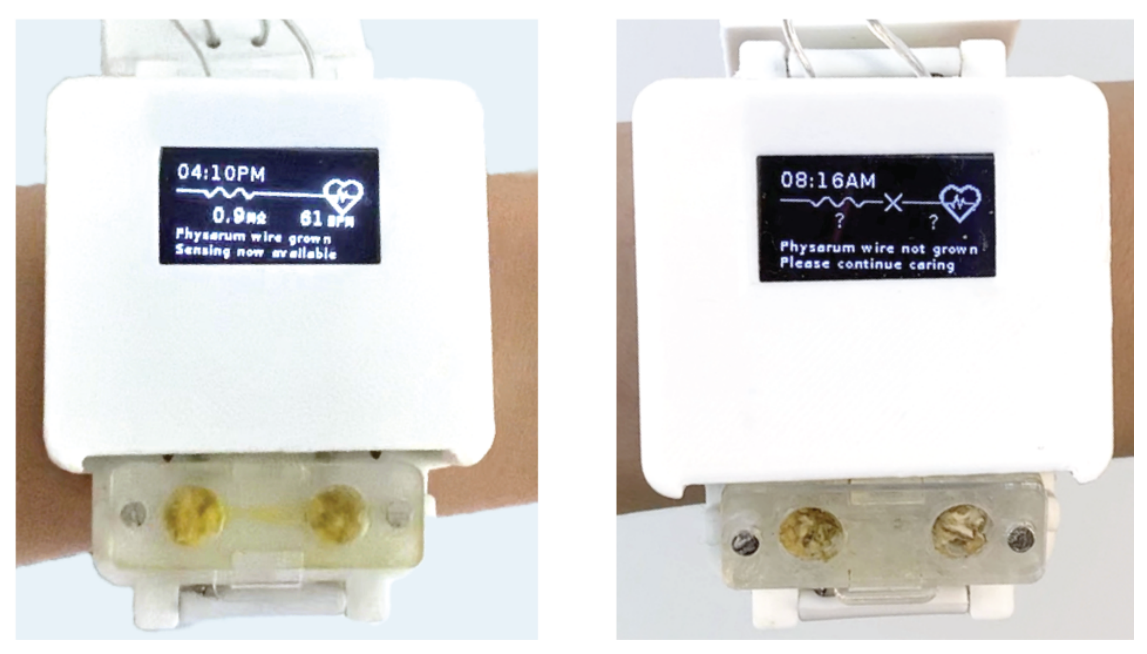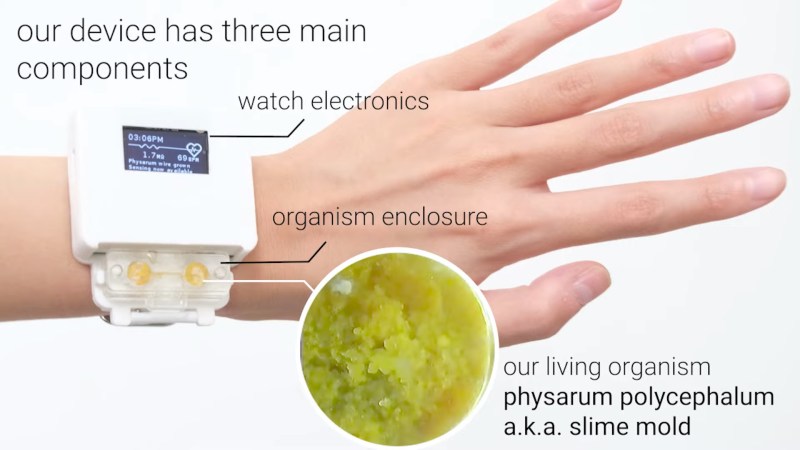Humans are very good at anthropomorphising things. That is, giving them human characteristics, like ourselves. We do it with animals—see just about any cartoon—and we even do it with our own planet—see Mother Nature. But we often extend that courtesy even further, giving names to our cars and putting faces on our computers as well.
A recent study has borne this out in amusing fashion. Researchers at the University of Chicago found that human attitudes towards a device can change if they are required to take actions to look after it. Enter the slime mold smartwatch, and a gooey, heartwarming story of love and care between human and machine, mediated by mold.
Looking After You

The research was based around a simple watch-based heart rate monitor. When powered up, the watch displays the user’s heart rate. The twist is that the watch features a slime mold as a “living wire.” When healthy and alive, the slime mold can conduct a small amount of electricity that enables the heart rate sensor. When dried up and dormant, the mold doesn’t conduct, and the watch shuts down. The user must keep the slime mold by alive by caring for it. If the mold is neglected, the watch shuts off until care is resumed and the mold is resucitated.

On the surface of it, it sounds very silly. It’s a heart monitor that’s more difficult to keep running than a normal one, which only requires infrequent battery changes. But the point of the study was to explore how the requirement to care for the mold influenced the human users of the device.
The study had users wear the watch for between 9-14 days. Over that time, the researchers found that humans formed a relationship with their watches, based around the fact that they were looking after a living thing. It inspired feelings of responsibility and affection towards the mold, spurring the users on to maintain and care for the mold.
Caring for the mold (physarum polycephalum) required regular attention. The mold needed oats provided every 2 days and droplets of water once or twice a day. The “living wire” simply connects power to the input of an op-amp which then enables the heart rate sensor on the smart watch.
The study involved five participants, four of whom expressed that they saw the slime mold as “a little friend and/or pet.” One participant noted that “carrying this little friend also made me feel happy and peaceful.” Another enlisted the help of her partner to maintain her slime mold while she was sick. “I was taking care of the slime and feeding it oats and stuff, my partner was also feeding me oatmeal because I was sick and so she was like you’re my little slime and I was like yeah, I am,” said the participant.

As a part of the study, participants were also instructed to neglect the mold and let it dry out as it drew to a close. Interestingly, this inspired feelings of sadness or guilt for all participants. Several referred to the mold as “dead,” though the dried mold is actually only in a dormant phase in that state. One noted that she avoided looking at the mold in this state, noting it made her feel “a little bit sad.” When asked about how they would dispose of the watch, several participants talked about rehoming it like a pet, or considered continuing to look after the mold in the absence of the device.
By and large, humans don’t spend a lot of time worrying about the life and times of their smartwatches, nor slime molds, either. And yet, the combination of one with the other created a device to be cared for that inspired feelings of warmth and responsibility in study participants. The slime became anthropomorphised to some degree, despite lacking any real personality or character traits of a sentient being.
In much the same way people bonded with Tamagotchi digital pets way back when, it seems the same effect can be generated with a simple watch and some greeny-yellow goo. Tell people to look after something, even a mold, and it seems they’ll bond with it and form a connection. It’s an interesting trait of our species, and an inspiring one at that.
[Thanks to ElytraMithra for the tip!]

















This is the kind of experiment where they always know what message they want to put across before they do anything.
The small sample size, and the tight researcher-subject association makes me a little nervous too.
That said, the device is fun. Would be really cool to develop more complicated circuits with slime molds. (For some strange value of “fun”.)
Researchers rarely if ever publish null results unless they set out to prove a null result, so this is pretty much the state of all modern research that gets published. You set out to prove something, and you find that it’s true. If you fail then nobody shall ever know of it.
It’s also harder to show that something isn’t the case, because there can be so many reasons for the outcome. Science cranks use this against attempts at debunking their junk, since they can always claim the experiment was done wrong or you just didn’t try hard enough, and oh look, here’s so many other cranks who successfully did it.
Not slime mold powered.
Slime mold activated, perhaps?
You’re my battery, motherf#$. [Groans] That’s all you are. I made you.
Were the creators too young to remember Tamlgotchi? Or are they choosing to bring that nightmare to life?
Just a bit of a nitpick, slime mold is not mold. I know mold is in the name, but they are not related
That slime mold is “clever” stuff.
https://www.wired.com/2010/01/slime-mold-grows-network-just-like-tokyo-rail-system/
You don’t know half of it…
https://www.gpf-comics.com/wiki/Fred
Great. Now I want one. :)
Is this really anthropomorphizing? Treating a slime mold like a pet does not seem like the same thing as “attributing human characteristics or behaviors to a non-human entity”
You’ve never closely watched one of those sneaky fuckers trying to outflank you and get you from behind, with the whole “I’m harmless I move so slowly” schtick and that inocuous baby shit yellow colour they use to lull you into complacency, have you?
Interesting article, I’ve often wondered when we would develop organic based memory, storage and cybernetic processor systems oh wait thats called having a baby these days d0h ]:o)